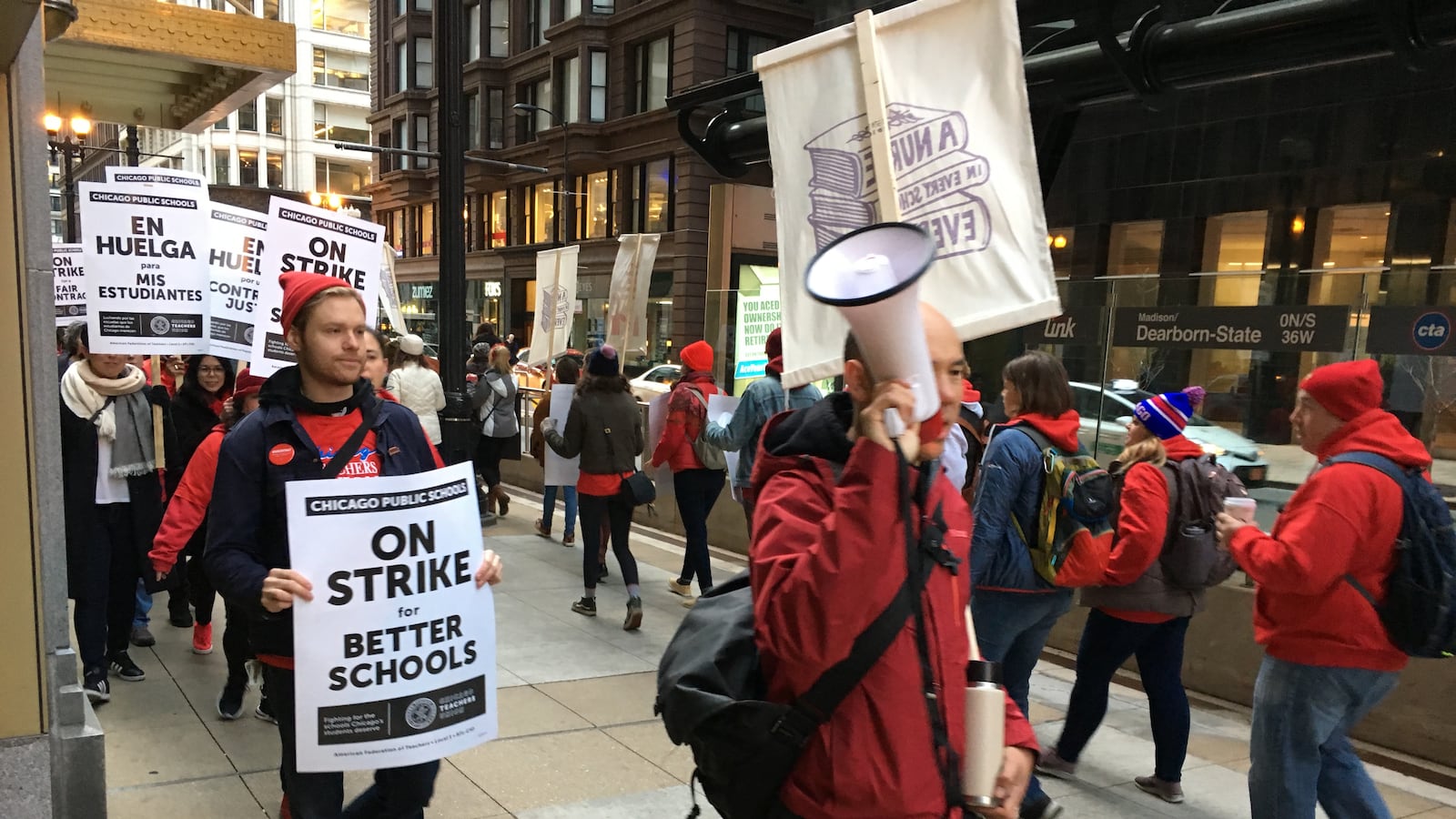Good evening, Chicago! It’s Day One of the teachers strike, and we’re fanning out across the city to bring you everything you need to know.
The basics: Classes and after-school activities are cancelled for roughly 300,000 students, but schools are open. Students may attend any age-appropriate school in their area, and administrators, non-union staff, and central office staff will be in charge.
Here’s a list of what we’ll be watching and here’s where we’ve been tracking every twist and turn of the negotiations.
We also need your help! Email us with photos from the picket line or from your child’s contingency camp, or insights about how the strike is affecting your school or family. You can also tag @ChalkbeatCHI on Twitter.
Follow our strike reporting team — Cassie Walker Burke, Yana Kunichoff, Kalyn Belsha, and Ariel Cheung — on Twitter and check back here frequently for updates.
6:55 p.m. No deal yet
Yana is camped out at Malcolm X to get the end-of-day update from the union’s bargaining team. When CTU members emerge, they say negotiations are done for the day, and there’s progress; however, a deal remains elusive. Confirming something reporters had heard throughout the day, union attorney Robert Bloch said there is now a written proposal from the city on class size, a central union demand. But the union said the proposal falls short.
Union negotiators also bring up a topic we haven’t heard before: a liaison for homeless students. The union has been agitating around housing issues, and it looks like one way district could appease this demand is some sort of case manager. But only for a handful of schools. We will write a full story with more from the update.
6:05 p.m. Robocalls begin
Parents start to receive robocall messages and e-mails from Chicago Public Schools that classes will be canceled again Friday — a sign that bargaining has ended for the day without a deal. The district also cancels also team practices and competitions for the weekend ahead.
Teachers, meanwhile, hear from union reps that they will be asked to report to their school picket line in the morning.
Chicago Public Schools reports that 462 schools reported 7,533 students in attendance. Schools will again be open and minimally staffed Friday, and families are again encouraged to register if they plan to send children.
3 p.m. Into the classroom
One notable dimension of the strike and its lead-up has been the window it has offered into teachers’ classrooms because of its focus on class size, teacher prep time, and other issues that are intimately entwined with what happens inside schools. That’s a contrast with recent strikes in other places that have focused more on teacher pay, which have illuminated teachers’ lives but had less to do with their ability to serve students.
We just published a First Person piece from a former Chicago teacher who said she left the classroom because she felt like she could not effectively help her students.
“Almost half of my students had special needs, and none of the students could read at grade level. I did not have a special education teacher that day, and I had to decide which of my students I would be able to help during that particular class, with the full knowledge that I wouldn’t be able to give extra attention to all of them,” writes Julie Kallas. “I couldn’t even considering paying special attention to any of my students who did not have special needs.”
Other teachers have shared their experiences on social media. This thread by Jeff Solin, a current teacher and parent, has been shared hundreds of times.
2:30 p.m. Citywide rally hits its stride — with signs
Ariel and Yana are downtown where thousands of Chicago Teachers Union members are coming together for a massive rally. Here’s one snapshot — and be on the lookout later for others that highlight the inventive signs that creative teachers cooked up.
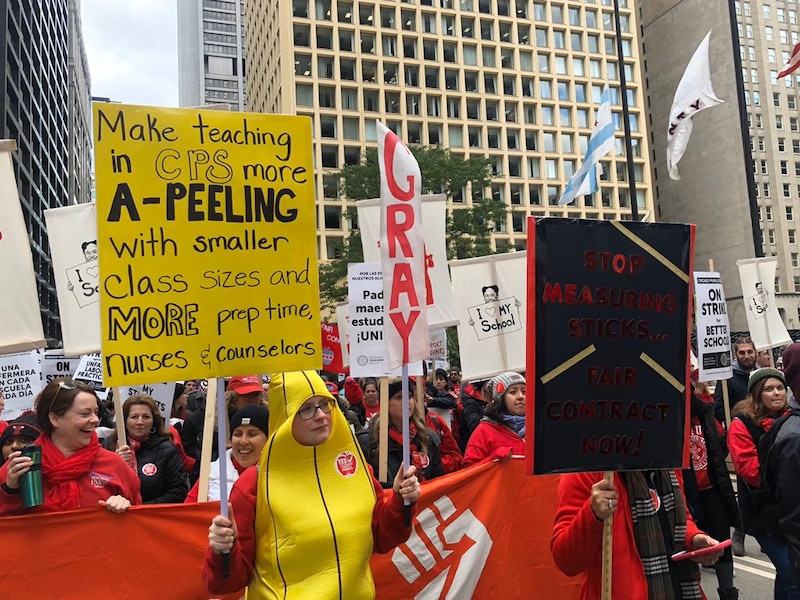
1:40 p.m. A bargaining lunch break
Chicago Teachers Union and City Hall officials have just stepped away from the bargaining table — to get something to eat, and for union leaders to head over to the citywide rally. Spirits are high and progress is being made, although a deal today is “very unlikely,” according to a Sun-Times reporter who’s on the scene:
1:32 p.m. Teachers in transit
Teachers who spent the morning picketing are now convening on downtown for a rally at Chicago Teachers Union’s headquarters. Yana captured a video of an L station transformed by union members — take a look (and listen).
12:45 p.m. “Spirits are a lot higher than in 2012”
At Benito Juarez Community Academy, Ariel met a teacher who offered an interesting reflection on how this strike compares to the one in 2012 that kept teachers and students out of school for seven days. Here’s her report:
Union reps at the high school said it had almost all its teaching staff striking Thursday morning, with 123 CTU members and 20 support staffers with SEIU waving signs at Ashland Avenue and Cermak Road. Members of Pilsen Alliance, a social justice organization, current and former students, and teachers from nearby schools also turned out. “It’s invigorating, and spirits are a lot higher than in 2012,” said teacher Alfredo Peralta. “That time, it felt like there was a lot more negative animosity, and this year I think people realize it’s not just about teacher compensation — it’s about the future of the city and the students of this city.” Even when considering Juarez as a “well-resourced school,” class sizes topped 40 students at the start of the year, says teacher Katie Kampton. Special education teacher Paul Johnson said his first class of the day has 38 students, 16 of which have special needs. “There’s one general education teacher and me,” he said. When so many of his students need individual attention, he added, “I can’t help 16 people at a time.”
12:25 p.m. A family picket
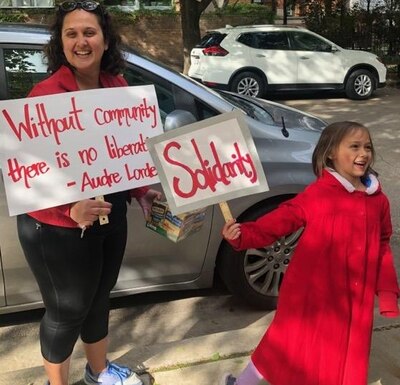
Reader Miriam Bhimani sent over pictures from her daughter’s visit to three picket lines this morning. Bhimani and her daughter hit four schools with special connections to the family.
Carnegie Elementary School in Woodlawn; Alcott Elementary in Lincoln Park; and Peck and Richardson elementary schools on the Southwest side. Bhimani’s daughter attends Alcott; a teacher who helped a student Bhimani supported works at Carnegie; and she taught a decade ago at Peck before Richardson opened nearby to relieve overcrowding.
“I still am friends with many teachers at both schools,” Bhimani wrote. “So we went down to show our support. In fact, my daughter is named after one of the students I taught at Peck!”
12:15 p.m. Hypothetical situations
Chicago Teachers Union members who cross the picket lines and go to work during the strike can face consequences from their union. Hannah Leone at the Tribune just posted a story outlining exactly what those consequences can look like — but notes that union officials aren’t too concerned about scabs.
Union members may also be unable to work, even if they wanted to. Teachers told Cassie this morning that their official Chicago Public Schools email accounts are disabled during the strike, so they can’t access Google Docs or Aspen, the school district’s student information system. One consequence, they said, is that they can’t communicate with parents who may be concerned about what the strike means for their children.
11:30 a.m. Hitting the airwaves
The Chicago Teachers Union is spending $100,000 on three radio ads aimed at pressing the city to accede to its contract demands. The ads — titled “Pace Setter,” “Track,” and “Promesas” — will start airing Friday on the city’s most-listened-to English and Spanish radio stations, the union just announced in a press release this morning.
11 a.m. “We could get a deal done today”
It’s crazy out there, guys. Kalyn just got a chance to share notes from Mayor Lori Lightfoot’s press conference this morning after she read to students at the Breakthrough FamilyPlex in East Garfield Park, as city officials were heading back into negotiations with the Chicago Teachers Union.
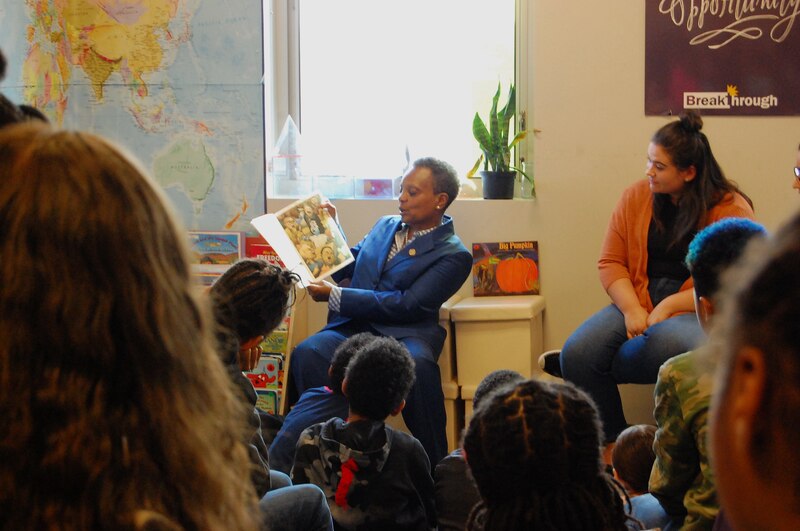
The students would have been in school today, but instead they got to hear Lightfoot read “A Bad Case of Stripes,” a picture book about a girl with a complicated relationship to lima beans.
Then the mayor answered questions about the state of negotiations, spelling out what it would take, in her view, to bring teachers back to work.
“What we need is for the union to come back to the table, to bargain in good faith, and spend the time actually getting a deal done, face-to-face with us, and not off to the side in a caucus,” Lightfoot said. “We need them to focus in the bargaining sessions on actually hammering out a deal and getting it done.”
Union officials have said that major sticking points remain. But Lightfoot sounded more optimistic. “I feel very good about where we are,” she said. She added, “We could get a deal done today.”
10:37 a.m. Going national
Randi Weingarten, president of the national American Federation of Teachers, is in Chicago today. This morning she picketed with teachers at three high schools – Taft, Lane Tech, and Whitney Young — and she just sent an email to AFT supporters nationwide. The email asks recipients to tweet their support for Chicago teachers and explains why the union is pressuring the city’s new mayor, Lori Lightfoot.
“She needs to know that the entire country is watching,” Weingarten wrote. “Just like we stood with teachers and school staff who walked out in West Virginia, Oklahoma, Arizona, Colorado, North Carolina and Los Angeles, we need to show that we have CTU’s back.”
10:30 a.m. Snapshots from the morning
Pickets at each school were scheduled to end now so teachers can prepare to head downtown for a massive rally this afternoon. That makes this moment the right one to share a few of the many snapshots from the morning’s rallies that teachers and others posted on social media. You can see others tagged with the union’s chosen hashtag, #Putitinwriting, a reference to what it says is Mayor Lori Lightfoot’s reluctance to commit formally to changes she says she supports.
From Taft High School on the Northwest side:
Bond Elementary School in Englewood:
Sheridan Elementary School in Bridgeport:
Ray Elementary School in Hyde Park:
10 a.m. “Going to try to take it day by day”
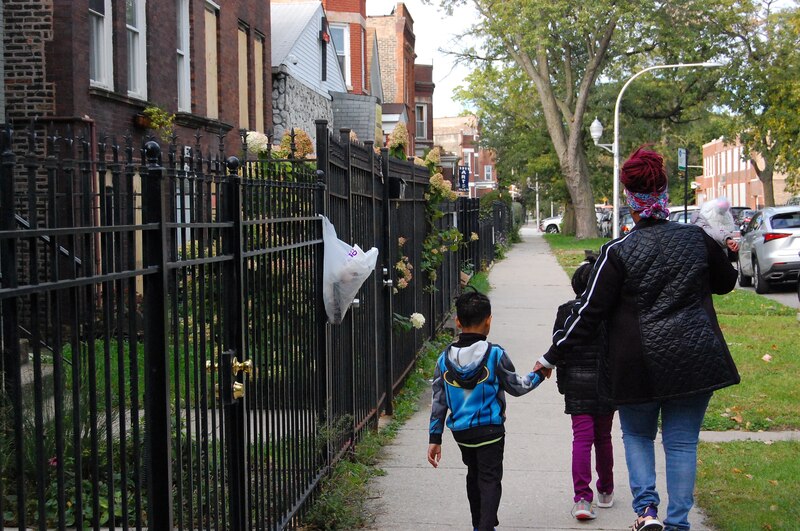
Kalyn just met a woman who changed her day because of the strike. Here’s her latest dispatch:
Jamiece Jamison exited the Breakthrough FamilyPlex in East Garfield Park just minutes before Mayor Lori Lightfoot was scheduled to give a press conference, as union members raised signs and chanted on the sidewalk. She was caring for her 6-year-old niece, who’s in first grade at Hawthorne Elementary, and her 4-year old nephew, who’s in pre-kindergarten at Greeley Elementary, while their mother was at work. She planned to take the kids to the library, then to feed them lunch. “Everything is kind of last minute,” Jamison said. “We’re just going to try to take it day by day.” Jamison lives in Oak Park, a neighboring suburb of Chicago, but she’d been following the strike coverage a little bit. She supported giving the teachers a raise. “I feel like they should be paid what they want,” she said. “Every day, teachers dealing with large classrooms, it’s a lot. I’ve always felt like teachers are under-appreciated. I don’t feel like they get their just due when it comes to salary.”
9:45 a.m. The (Work)Force Awakens
Ariel stopped by Benito Juarez Community Academy, a high school in Pilsen, where teachers are still smiling after hours on the picket line. One had an especially attention-grabbing handmade sign.
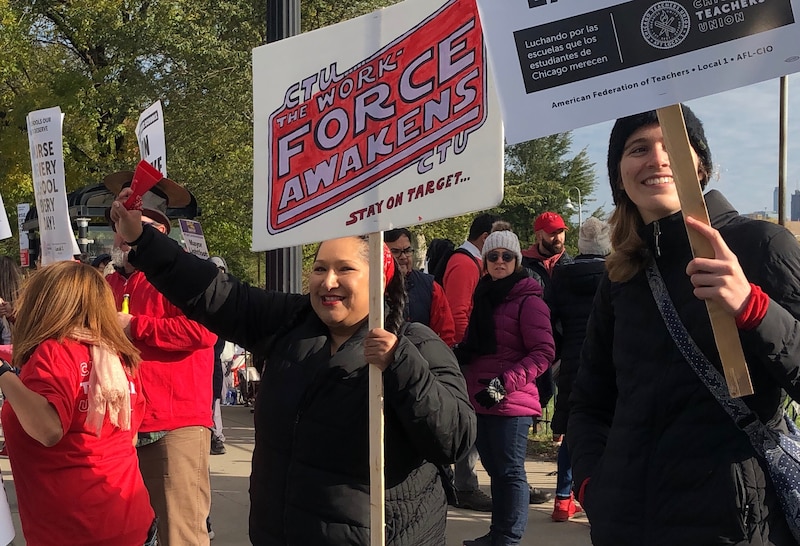
9:15 a.m. On class size
Cassie just filed this report from Ravenswood Elementary School, which the union says has the largest average kindergarten class size in the city.
Molly Mehl teaches kindergarten at Ravenswood. Last year she had 34 students in her classroom and the school filed a grievance with the union to get her an aide. It took two months. This year she faces a similar class size — and a similar situation. Her principal has tried to help by sending in special education aides, but Mehl said, “Another adult sounds great on paper but other adults coming in randomly means you are managing adults. We have very little time to sit down and work with children, to connect with children. I used to have four small groups for reading and math. Now I have seven. Its hard to even get to them all once a week.”
9 a.m. The Lightfoot report
As Mayor Lori Lightfoot and other city officials head back to the bargaining table right now, we can share two views of Lightfoot’s world, from Wednesday night and this morning.
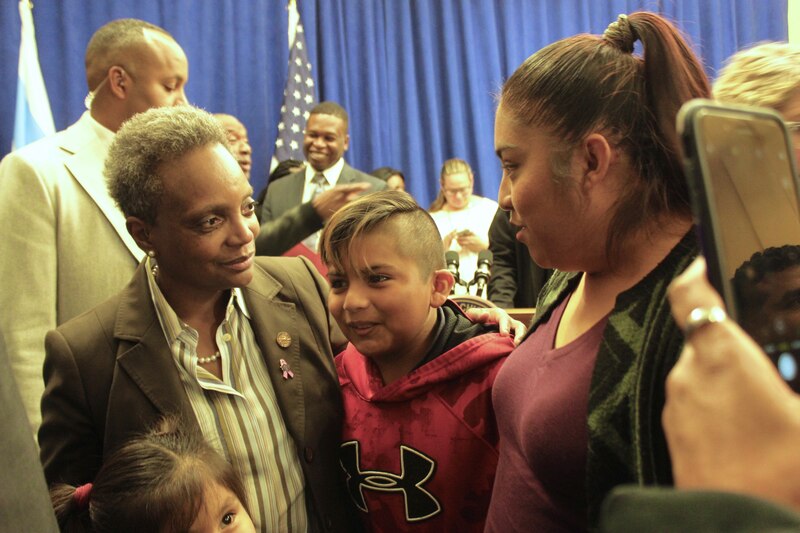
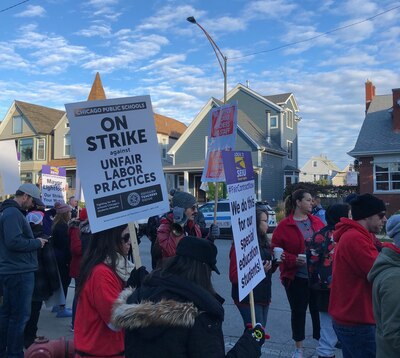
On Wednesday night after her press conference in Pilsen, Nury Ortega and her son Alexander Perea-Ortega made a point to get a word with the mayor. “I know it’s hard to find the money,” Ortega said. “But for us, it’s really important. We need teacher and support staff.”
Her son’s school, John Spry Community School in Little Village, only has a nurse in the building two days a week, and counselors are in short supply too, the fifth-grader said. “So when we get hurt and it’s not one of those days, we’re just supposed to go to the office,” Alexander said.
Protesters were outside Lightfoot’s Logan Square house on Thursday morning. Our reader Bree McKenna sent this picture from the scene:
8:45 a.m. What kids are up to
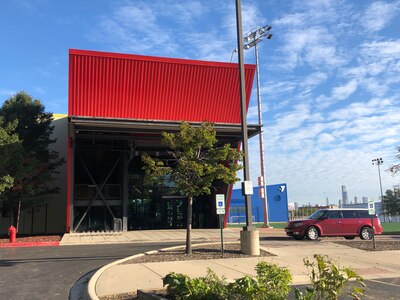
Ariel is out talking to families whose daily routines have been disrupted by the strike. Here’s what she heard from one of them:
Claudia Hernandez dropped her children off at the Rauner YMCA Thursday morning. While the students normally attend Franklin Fine Arts Center, they go to Rauner for summer camp, so Hernandez knew it would be a good place for them to spend their day. “I support our teachers,” she said. At the same time, she added, “We hope it’ll be over today.”
While Ariel was at Rauner, she saw someone from the Greater Chicago Food Depository drop off a supply of Goldfish crackers. The food bank is supplying snacks, fruit, and in some cases cold meals to locations across the city where students who might otherwise rely on school lunches are likely to be. Find a distribution site here.
We’re also getting notes from museums and other institutions who know that families might looking for a way to fill time. For example, the Museum of Science and Industry sent an email this morning — that didn’t actually mention the strike — pointing parents to online resources “for kids to continue learning at home.”
8:30 a.m. Meet the union leader
According to the schedule that the teachers union distributed last night, now’s the time that Vice President Stacy Davis Gates is set to appear with striking teachers at National Teachers Academy. The school fended off closure with a lawsuit last year.
If you haven’t read the Sun-Times’ fascinating profile of Davis Gates, who began teaching in Englewood in 2004, now is a good time. In the profile, which ran over the weekend, she offers another explanation for why the union is making demands that go beyond compensation — and why it’s doing so now.
“We get to give voice on these things because the convergence of all of society’s ills comes into our classrooms on a daily basis,” Davis Gates told the newspaper. “It is a shock to me that this is a shock to everyone else. We are chief players in promoting and educating the common good.
“There’s historical, generational unfairness baked into the system. So this contract fight is about all of those chickens coming home to roost at the same time.”
8:10 a.m. Notes from a nurse
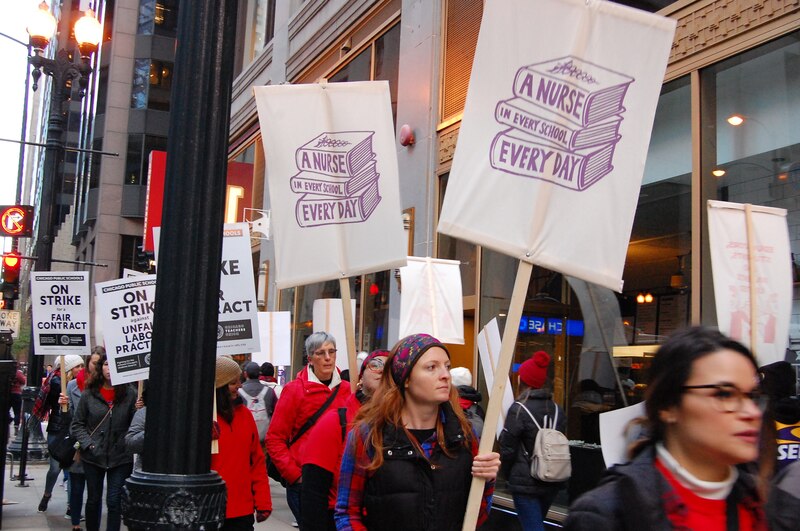
Kalyn has filed a longer dispatch from the downtown picket by citywide clinicians — which include social workers, nurses, school psychologists and others — aimed at drawing attention to Chicago Teachers Union’s demands for higher levels of support staff in schools. Here’s what she learned from one nurse on the picket line:
Carol Reilly was one of the certified school nurses picketing downtown. Reilly said she’s split between five elementary schools on the North Side of the city. Her duties involve everything from developing Individual Education Programs for students with special needs to helping students use inhalers, read food labels, and cope with seizures and asthma attacks. “It’s hard because you’re not seeing the children every day, so you’re not seeing if there is a health decline or you’re not seeing if they’re not coming and using their inhaler daily or you’re not able to make sure that they’re making the right choices regarding food if they have a food allergy,” Reilly said. Nurses have been a crucial bargaining point not just in Chicago, but also in Los Angeles and Boston, where teachers won higher staffing levels of these staff in their contract negotiations earlier this year. Reilly said if the Chicago teachers and other school staff were able to get more nurses guaranteed in their contract, it would make a big difference in her job because she’d be able to see students more often, address their health needs on a daily basis, and follow up more quickly with other staff and parents. “Nurses are spread so thin and nurses’ responsibilities, unfortunately, have been put on clerks and other staff,” Reilly said, adding that other staff have been tasked with things like giving out daily medication for students. “It’s obviously something that needs medical training to do. And I think it’s getting difficult for other people to confidently do these tasks.”
8:15 a.m. A 25-year veteran’s view
Before heading off to another school, Cassie got a chance to talk to a teacher who has worked at Peirce Elementary for more than 25 years. Here’s what she heard:
Ted Wanberg, 57, is a longtime kindergarten teacher at the school. He has taught here since 1993, before it swelled and became a destination neighborhood school. He remembers class sizes of 22 or 23, but a decade ago they starting swelling. Now he regularly has 30 kindergarteners. He gets some help from a recess aide but not all day. “What I value in a smaller class is being able to sit with each child, look them in the eyes,” Wanberg said. “It’s important with young children — and it’s hard to do with 30-plus in a classroom.” The city’s approach to class size issues of having more aides isn’t the answer, he said. “That’s just more bodies in the class. We need fewer.”
8 a.m. T-minus 90 minutes to bargaining
We’ve just gotten an update that bargaining between CTU and the city will resume at 9:30 a.m. after being called off Wednesday afternoon to allow for strike preparations. The talks will take place at a neutral location, Malcolm X College.
Cassie just spoke to union chief Jesse Sharkey who said the union still had not seen a written proposal from the city about staffing numbers for support workers. Earlier this week, Mayor Lori Lightfoot said she would make an offer, which represented a change in her position, but the union said it could not make a decision about accepting it without seeing it in writing. That apparently still has not happened.
Sharkey also said the union is prepared to make concessions. “Of course, it’s negotiations,” he said. “We don’t expect to fall asleep in Edgewater tonight and wake up in Winnetka. We are doing this because children deserve basic supports in their neighborhood schools.”
7:48 a.m. Donut report
Last year I ran into trouble when I tried to have coffee delivered to our Chalkbeat reporters in Denver who were covering a teacher strike there: Cardboard coffee dispensers were sold out citywide because local residents had sent them to picket lines. Now, the first reports of solidarity-snack shortages are emerging in Chicago:
7:25 a.m. Solidarity forever
Messages of solidarity have poured in for the Chicago Teachers Union in the days leading up to the strike — from unions and their members in other places and public figures, including Democratic presidential candidates, who are sympathetic to workers’ issues.
Last night, Bernie Sanders tweeted a message of support emphasizing that Chicago teachers are fighting “for the common good.” That’s a reference to the union’s approach to bargaining over issues that are broader than just members’ pay and benefits. Check out Kalyn’s primer on “bargaining for the common good” for more. For now, here’s a message from a Los Angeles teacher who met a Chicago colleague on the picket line when her union struck last year:
7 a.m. Citywide workers convene downtown
While school-based union members picket at their schools, their colleagues whose work is citywide have gathered outside the union’s downtown headquarters. Among them: some of the nurses and social workers whose numbers have emerged as one of the stickiest issues at the bargaining table. Mayor Lori Lightfoot has said she supports the union’s call for more support workers in schools but cannot responsibly write the union’s preferred staffing levels into its contract.
The staff at union headquarters are chanting that every school needs a nurse, Kalyn reports.
6:55 a.m. About the timeline
CTU chief Jesse Sharkey is emphasizing the timeline he sketched out earlier this week, when he told Chicagoans to gird themselves for a “short-term strike that is going to cause some difficulty and pain.” Speaking at Peirce Elementary, he says, “It’s time for the mayor to get a fast contract settlement.” Later, he adds, “It doesn’t have to be a long strike but we need real solutions.”
6:30 a.m. On the picket line
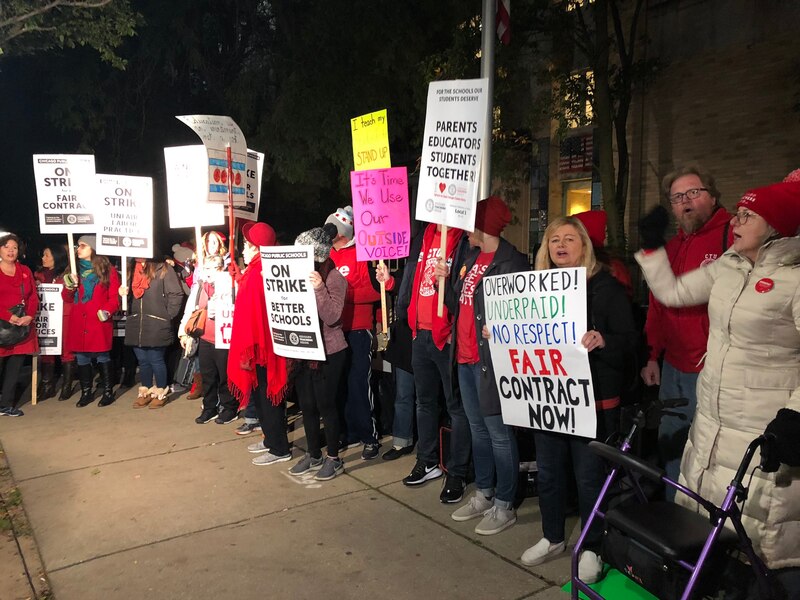
It’s still dark out, but picket lines have formed at schools across the city. Teachers at Helen C. Peirce Elementary School in Rogers Park are preparing for a guest: CTU President Jesse Sharkey. He’s one of several union officials planning to make appearances at local schools before heading back to the bargaining table later today.
As teachers wait for him to begin speaking, they shout “Whose schools? Our schools!” Cassie reports. Peirce is a thriving neighborhood school but Jeffrey Rossiter, a Peirce teacher, says “years of austerity” have galvanized teachers there.
The Peirce teachers are also joined by teachers from nearby Passages Charter School, one of several privately managed schools whose teachers have opted to be represented by the Chicago union. They’re not officially part of the strike because they have a different contract, so Passages will open as usual later this morning — but for now, they are offering solidarity.


